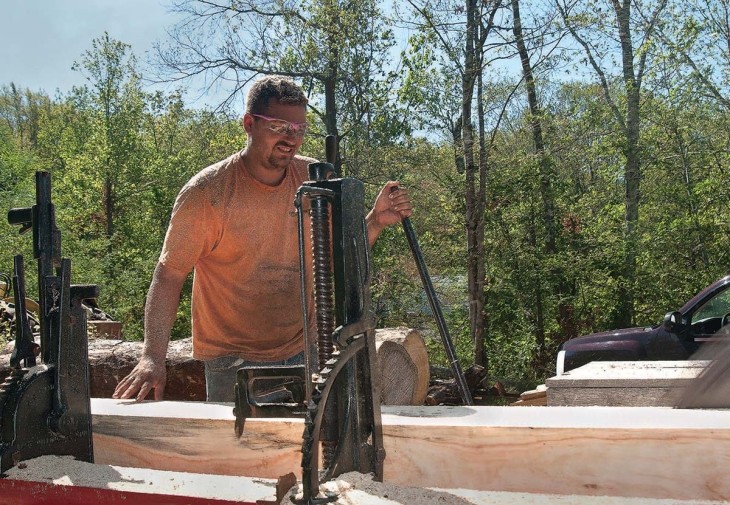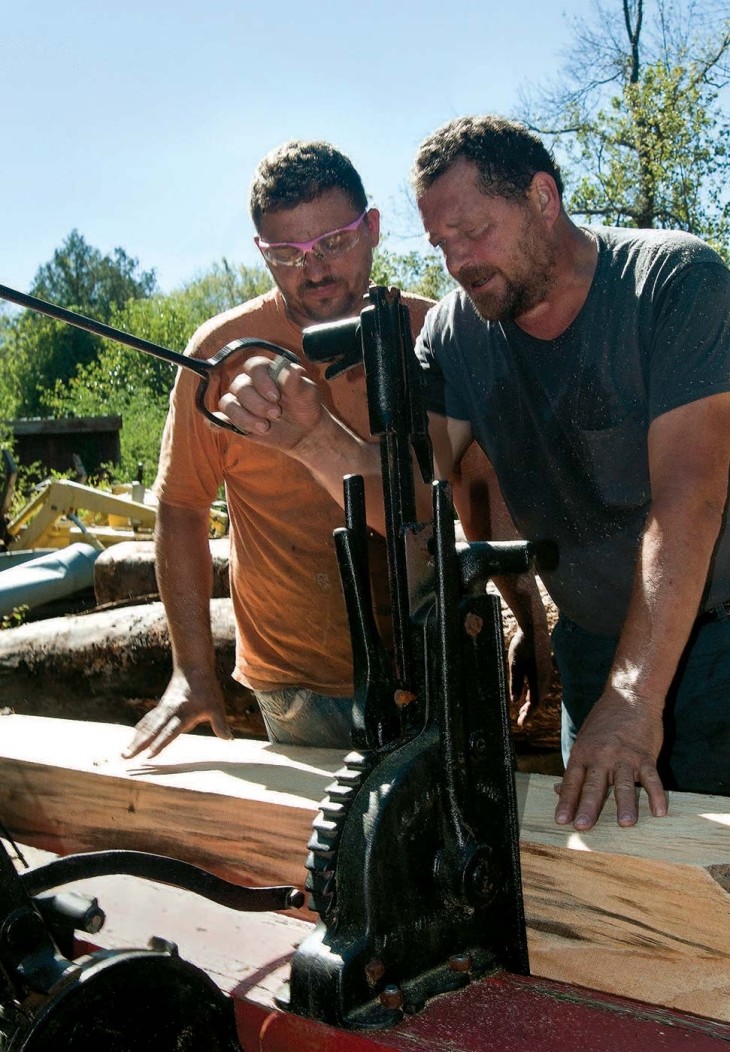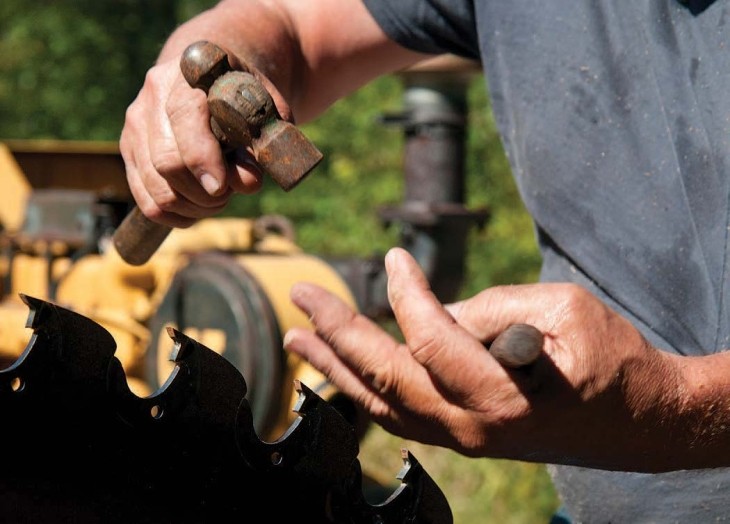Dale Brooks says it was Sonny Congdon who taught him how to saw, and so John Rozensky would have helped teach him as well because Sonny and John were working together at that time running Congdon’s sawmill in Lyme, Connecticut. They showed Dale how to sharpen the saw teeth, about the lead of the saw and how it’s measured, what the speed of the saw blade has to be, and how you can read it in the pattern that’s cut in every board.
He said Sonny used to finish swaging the saw by tipping his file into the front of the blade spinning at more than 600 times a minute, so that the file would hit each tooth corner for the slightest instant. Swaging is an action that spreads the edge of the tooth to make it wider than the rim of the saw, so the saw plate will pass through the log without rubbing against the sides of the cut. And he’d do the same thing on the inside of the saw. It made a light, kind of quick, electronic noise, like space music. And everybody’d laugh.
Dale had a sawyer’s manner about him from the start, the sawyer’s conceit I guess you’d call it, that sense of authority they all seem to have. And well they do, because it’s their responsibility to bring the saw up to speed and spin it down the log.
It’s wintertime, 1986. Three of us are sawing railroad ties, working really hard to make 100, 125 ties in a day on the wet, slippery mill deck. Erwin Dill is tail sawing for Dale in the mornings, and I’m carrying slabs and peeling bark off the ties with an ax.
We’d wait in the lath shed before work where there was a wood stove made from a fuel tank beginning to burn. Dale usually got there last, driving a wreck of an old blue Toyota pickup with his 3-year-old son Michael bouncing up and down on the seat beside him. He was a sturdy, bronze-haired boy with big, light blue eyes. Dale would help Michael unzip the top of his silver snowsuit and take it off. Most mornings he was wearing a plaid flannel shirt underneath, just like his dad’s.
Dale would lift his son up onto his lap and start talking slowly, patiently; cluck, cluck, clucking like a mother hen. And Michael would stare up at his father with those huge blue eyes of his, with all his might and all his trust and all his love. Then Dale would set Michael down, remind him once more not to touch the stove because it’s hot, turn, and walk out of the shed to leave him alone while we sawed for two, two and a half hours, until 10, or 10:30. Our break.
The trust Dale had in his son amazed me, when Michael was only 3 and 4 years old. It was like they had a covenant, do you know what I mean? I know that’s an old-fashioned word that’s lost a lot of its meaning. Still that’s what they had, a covenant, or so it seemed to me.
In his 60s now, Dale lives on a narrow country road that slips through the hills along the east side of the town. It must be good karma that finds him living with his wife Amy on top of a granite ledge that rises some 30 feet above its surroundings – high enough to be out of sight, where the air’s that little bit cleaner, where the sirens from town are just a little more distant, where the sound of his saw gets lost in the clouds. And if you take the time to notice, you’ll see that they’re living among the treetops, with the crowns of young hardwood trees all around them; the oaks and maples, the hickories and poplars are all represented, each one standing straight and tall at the right height to shield their place from outside.
To the right is their house, set at a slight diagonal on the high end of the lot. It’s one story with new brown vinyl siding. To the right of the house is a gazebo Dale built for Amy, open sided like a carnival booth, that she has decorated with found objects: lengths of chain, some old enough to be forged by hand; a small breadboard with the painted words Our Daily Bread faded and chipped; tools and utensils, some left to weather to black and rust brown, while others are painted in light, primary colors happy as can be.
In the middle of the lot is Dale’s workshop: an old two-bay garage, with one of the doors replaced by a concrete-block chimney and single wood door. Part machine shop, part woodshop, and dart hall as well with a small wood stove by the door, a couple of chairs, and a small refrigerator. He’s got a drying booth in back for his cabinet and furniture jobs and the guitars he makes – 34 and counting, but that’s another story.
His sawmill is behind the shop. It’s made up of a Simonds saw blade manufactured sometime after the second world war, in the late 1940s or early ’50s; he’s not sure. The date has worn off. It’s 48 inches in diameter and has 42 teeth. Like most Amidon mills, the carriage and tracks are made mostly of wood.
Amidon sawmills were manufactured by the Charles Amidon Company in Willington, Connecticut, from the beginning of the nineteenth century into the early 1950s. These sawmills were found mostly, but not entirely, in that part of the state and in western Rhode Island. It’s a light, portable machine, neither as heavy nor as expensive as the Lane and Chase mills that were also used in the area. Just the right kind of setup for a family with boys to work and make a go of it 75 or 100 years ago.
Dale got his mill from Bob Congdon to settle a labor bill when he stopped working there for good in the late 1980s. With help from his brother Allen, Dale trailered it up to their father’s place in Vermont: the mill carriage and track, a Caterpillar power unit, the saw blade, and an old yellow Ford tractor with forks.
Michael was with him, of course.
It took most of a year to get the mill set up, but finally he started sawing. He made ties for a couple of years. But Vermont winters were long and cold. Dale says he’ll never forget the smile on Michael’s face when he got the call from Bartlett’s mill in North Guilford asking if Dale wanted to saw for them. So in l994 they came home to Connecticut. Dale brought the Amidon back with him and stored it outside at a friend’s place on Sterling City Road in Lyme.
The operation in North Guilford was larger than any mill he had worked with before. It had an HMC plant set up in the early 1980s with a Silva Tech computer-operating system (HMC Corp is a sawmill manufacturing company in New Hampshire). He says it didn’t take long to figure it out. After a couple of years, Michael started there, too, first working on the green chain sorting and piling lumber.
Dale bought his house from his boss Sam Bartlett in October 1995. It was just a shack then. Took a long time to make the place nice. Michael got married and lived there for a while with his wife Kristin and two kids. In 2007, Dale had a massive heart attack. He went back to work after two weeks, but he didn’t like sawing at the mill in North Guilford after that and quit a year later. Then he worked a couple of years at The Home Depot.
He finally got the Amidon up from his friend’s house in Lyme in 2012, and started it running again, painted it Amidon’s factory colors: scarlet red and jet black. Set it out in front of the lot with its track running along the edge of the cliff in back, overlooking the swirl of wild green kudzu growing in the valley below.
It’s early on a September morning in 2017. The mill is in shadow. The saw blade has rusted to a soft chocolate brown, the red paint on the carriage is faded and chipped, the wood underneath is bleached silver.
The tractor starts in a series of coughs and chugs, sending up a column of blue-gray circles of smoke, each one the size of a softball. Sunlight fills into the lot over the tops of the trees. Dale loads the mill skids with three birch logs, gray, naked looking, stripped of most of their bark, and then four oak logs, resolute and strong as oak always seems to be.
He swages the saw teeth first and then sharpens them. I have always seen it done the opposite way, sharpening the teeth first and swaging them afterward. The work sounds he makes here are softer than at most mills. It must be the surround of trees that muffles it. His hammer on the swage tool makes a quick, soft ting that echoes across the lot and is gone. The file’s slide across the saw tooth is just a whisper, once and then twice, three times.
Today Michael is going to saw on the Amidon, something he’s never done before. It’s not that he doesn’t know how to saw – he worked with his father for years at Bartlett’s and later stayed on when Pete Marlow took over, running the re-saw and processing the large cants they made on the head saw down to smaller dimensions. Sometimes he’d give the sawyer a break on the main saw. So he knows the formulas and how to make the calculations for sawing lumber.
The diesel won’t start, its battery dead. Luckily Michael has a new one the same size in the back of his truck. He runs to get it.
Michael lives now with his wife and family the next town over. He’s a member of Local 978, International Union of Operating Engineers in Hamden. He works for a big land-clearing company whose main yard is just down the road. There he maintains and operates some of the largest timber harvest equipment on the East Coast.
After two or three turns of its starter, the diesel fires with the rattle of steel and a cloud of white smoke. Dale runs the carriage up and down the Amidon’s wood tracks; it makes a distinctive sound, softer and hollow compared to the sound on a steel track.
At the mill in North Guilford the sawyer sits in a booth like a pilot or locomotive engineer. He never touches the log that he’s sawing; he’s 10 feet above it. He controls the run of his mill with foot pedals, and toggle switches in two box-like hands on iron arms that reach out from a green box in front of him. There are red, white, and orange push buttons on the top of the box. A bright red laser light shines along the top of the log and shows him the saw line. A gauge that stands on the far side of the carriage looks like a clock face with one long, red needle swinging back and forth to read him the width of each cant.
Sawing on the Amidon is different. Sawing on an Amidon is like stepping back in time.
The sawyer has to make a plan for how he is going to saw out his log. Sawing on the Amidon, he does the math in his head. With the Amidon, the sawyer stands on his own two feet. He is constantly rolling, turning, and pushing on the wood as he saws it.
Michael is behind his father, watching as Dale saws out the last birch log.
Now it’s Michael’s turn to saw. He asks his father a question; you can tell by the way Dale gestures that he’s explaining the set works: a system of levers and gears, pinions, and racks that move the backs of the carriage, properly called knees, forward and back.
They switch places. Michael taps the saw pole for luck. Working to get a feel for the carriage, he lifts up the set arm, which drops its far end, called the pawl, onto the right side of a gear wheel. The wheel is cast with two circles of teeth that are worked by two different pawls; the back pawl’s on the left, the front pawl is on the right and works what’s called the board notch, which is a circle of gear teeth in 10 sections, each section made up of 5 teeth.
You can tell that Michael has learned the things he needs to know, that he’s learned how to learn, you might say. He pulls the set arm to him and makes a one-tenth rotation of the board notch, which turns the set wheel, moving what’s called the set beam that runs the length of the carriage, advancing the four knees toward the saw line by an inch and a quarter.
Then, as he has seen his father do hundreds of times, Michael turns the set arm counterclockwise, which tightens a light chain hanging off it and raises both pawls. The carriage is free to move forward or back. He lifts his hand, dropping one point of the right-hand pawl onto the back of the board notch, making the same tenth of the circle turn, but this time in reverse. This causes the knees to recede; he repeats the action once more, to make room for the first oak log.
He picks up the cant hook; holding the tool with both hands, he cuts its point into the log. Pulling on the hook’s wood handle he starts the log turning toward the carriage.
This is a dangerous time because the saw pole behind him is left unattended; there’s the chance it could fall off center and start the carriage rolling toward the saw.
Reversing the hook from top to bottom, Michael catches the log underneath and lifts it in quick turns once, twice, until it lies flat on the carriage blocks and is still. He drops the hook to the deck. With his right hand he reaches out for a spike called a dog and pushes it into the log, screwing it tight with his left hand. Each action takes only seconds. Even beats of a second.
Michael reverses the turn of the set arm; he lifts it up and to him, which drops the front pawl into the top of the board notch. He pulls the arm to him and down once, twice again and the log is pulled forward and set.
Then he turns, and this is what seems the hardest to me: he reaches for the saw pole with his left hand, pulling on it with just the right amount of pressure to tighten a pulley belt that sets the speed of the carriage, with the saw’s speed constant at this point, so the log is pulled into the saw at the speed that causes one saw tooth to cut one chip of wood, approximately an eighth of an inch thick and a quarter-inch wide, from the log.
The saw seems to sing when it whirls into the log. Michael raises his right hand up to cover his face as a cloud of oak sawdust and fragments of bark fly into the air; it’s lit gold in the late morning sun. He pulls the log past the saw and straightens the pole to stop it at the end of the tracks. Then he pushes the saw pole away from him to the other end of its arc, which causes the carriage to return – or gig back as the action is called – in a smooth, quick motion for which the Amidon sawmill was prized.
What a privilege to take a picture of something as real as this. I trust I haven’t gotten too close. But I know a good story warms a great picture even more. My thanks to them both.






